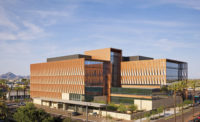Laongo, Burkina Faso
Like most African nations, Burkina Faso struggles to provide adequate health-care services for its citizens. In this landlocked West African country, there is only about one doctor for every 20,000 people; the average life expectancy is 58 years; and roughly 10 percent of Burkinabe children die before the age of 5.
Composed of rectilinear volumes made of clay and concrete, the 14,000-square-foot clinic opened last fall in Laongo'a rocky rural area about 25 miles from Ouagadougou, the country's capital. The $500,000 project was built by volunteers from the German nonprofit Gr'nhelme (Green Helmets) and local workers, who earned a small wage and gained valuable skills. 'People were really motivated to help because the project created opportunities for them,' says Kéré, noting that the country's GDP per capita is $720 per year.
The clinic is one of a dozen civic-minded projects that the award-winning architect has designed for his homeland. Kéré runs a small studio in Berlin, where he earned his architecture degree, but he remains focused on creating sustainable and low-cost buildings for underserved areas in Africa. His growing portfolio includes schools, health centers, and cultural venues on the continent, in addition to more lucrative European projects that help support his practice.
The clinic is part of a larger mixed-use development known as Opera Village. Encompassing 37 acres, the ambitious project was spearheaded by Christoph Schlingensief, an avant-garde German film and theater director who envisioned building a world-class performing-arts venue in Burkina Faso. He commissioned Kéré to design the village, which over time evolved to include housing, a primary school, and a medical facility. Schlingensief had cancer when he initiated the project; he died in August 2010, just eight months after construction began.
The development has, nevertheless, continued to take shape, with funding coming from Schlingensief's nonprofit organization, Festspielhaus Afrika, and various donors. The school opened in 2011, as did several small art studios. Eleven single-family dwellings have been built, now occupied by teachers, medical professionals, and foreign visitors. In total, 16 structures have been completed at the site, all of which feature natural materials, passive ventilation, and a modernist design vocabulary merged with local motifs.
The new medical center sits on the periphery of the development, since Kéré wanted sick patients separated from entertainment facilities. Resting atop a concrete and stone foundation, the building comprises three boxy volumes organized around a central reception area. Each space has distinct programming'gynecology and obstetrics, dentistry, and general medicine'and each contains a landscaped courtyard. The open-air enclosures aid in natural ventilation and also provide a place for family members to congregate, which is an important consideration in Burkina Faso. 'You have to provide a space for relatives to stay, a place for people to gather,' said Kéré. 'This is embedded in African culture.'
The building's design marks a departure for Kéré in that there are no exterior clay walls and no overhanging roof (which shields earthen walls from rain)'both standard elements in the architect's Burkinabe projects. For this building, he employed a double-skin facade, using concrete blocks for the outer layer and compressed-earth blocks for the inner wall. The roof, made of sheet metal and supported by steel trusses, does not extend beyond the building, as shade-producing eaves would have attracted animals seeking respite from the sun. 'You don't want to have animals staying here when you have newborn babies inside,' Kéré explained.
One of the center's most distinctive features is its fenestration'a seemingly random array of operable square openings. These 'picture windows' not only pull in fresh air but also frame views of the surrounding terrain. 'We are in a beautiful area. I wanted people to have a connection to this fantastic landscape,' said Kéré. 'I wanted patients to have a view of the nature around them, whatever position they are lying in.'
Inside, modest rooms have exposed-brick walls, tile flooring, and locally made furnishings. Power and water are supplied by public utility networks, along with rooftop solar panels and a deep well. The regional government now staffs and manages the clinic, with some support from foreign organizations.
The facility is attracting patients from across the region, who are drawn to its exceptional design and level of care. 'There are other medical centers in the area, but this is a model of quality. And we really want to deliver quality for the people,' said Motandi Ouoba, director of the Opera Village. 'There are many people taking the road to come here because they know they can get the service they need.'
PeopleArchitect: Architect: Kéré Architecture ' Diébédo Francis Kéré, principal and lead architect; Ines Bergdolt, Dominique Mayer, design team General Contractor: Gr'nhelme, Association Dolai Client: Festspielhaus Africa Size: 14,000 square feet Project Cost: $611,000 Construction Cost: $444,000 Completion date: November 2014
|









Post a comment to this article
Report Abusive Comment